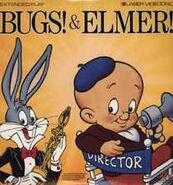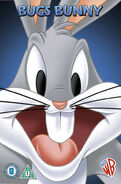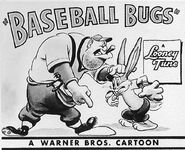Baseball Bugs is a 1946 Looney Tunes short directed by I. Freleng.
Plot[]
A baseball game in New York City is in progress. The two teams playing are the visiting Gashouse Gorillas, consisting entirely of big, aggressive, hulking tough guys, and the home team, the Tea Totallers, consisting entirely of weak and frail elderly men, one of whom claims that he is 93 1/2 years old. By that point, the Gorillas have dominated the entire game, and one of the Gorillas even belts the umpire into the ground after disagreeing with his call; he first said "BALL" but after the beat down, he changed it to "STRIKE", said that he was sorry and didn't know what had come over him, and then fainted and fell into a hole. Shortly after, the Gorillas go into a conga line making hit after hit after hit.
Bugs, who is watching the game from a hole on the field, is fed up with the game and the Gashouse Gorillas playing dirty. He starts talking trash about them by saying that he could beat them all by himself. The Gorillas hear him and accept his challenge. And now Bugs is playing the entire team, with the scoreboard having Bugs' name replacing the Tea Totallers' name.
Bugs decides to do a slowball. He winds up, then brakes and throws the ball slowly, sputtering like a car engine dying. Three Gorilla batters in a row strike out on this one pitch.
Next he goes up to bat. On his first time hitting the ball, the Gorilla that accepted Bugs' challenge is about to tag him out, until he is distracted by the sight of a pinup picture, giving Bugs a safe run home and thereby scoring his first run. On his second hit while running the bases, that same Gorilla grabs the umpire and takes his place in an attempt to put Bugs out. This leads to an argument which ends with Bugs pulling his time-honored word-switching gag so that the umpire demands that he accept the safe call or go to the showers. He gives in, but the faux-umpire gets wise too late as Bugs scores his second run. Thirdly, another Gorilla runs to catch the ball. "I got it! I got it!! I GOT IT!!", he yells. The ball hits him so hard in the face that it drives him under the ground, and a tombstone pops up with the epitaph "He got it." The fourth hit sees another Gorilla smoking a cigar also taking it in the face, smashing the cigar and driving the fielder up against the fence, in front of a billboard that reads "Does your tobacco taste different lately?" The last hit has the ball hit each Gorilla player like they were elements from a pinball game. The scoreboard even flashes numbers and lights up the word "TILTED".
Bugs is back on the pitching and catching side. He makes a pitch and a Gorilla hits it and runs around the diamond. Bugs is waiting for him and tags him. As the Gorilla is hallucinating, Bugs holds up a sign that says "Was this trip really necessary?"
A song asking for the current scores is played and the scores show that Bugs is now in the lead 96–95.
Now in the last half of the ninth, according to the announcer, the Gorillas can win with a home run. One Gorilla chops down a tree to use as a bat. Bugs attempts to “paste this pathetic palooka with a powerful paralyzing perfect pachydermous percussion pitch”, but it is to no avail as the ball is hit. In desperation, Bugs chases after it. Bugs first takes a cab, but the tricky Gorilla is driving it and steers Bugs away from the flying ball. So Bugs quickly gets out and takes the bus which takes him to the Umpire State Building. Bugs goes up an elevator, goes up a flagpole, throws his baseball glove in the air and finally catches the ball. The Gorilla comes to the top of the building as well and corners Bugs. But the umpire also reaches the top by climbing and says "You're out!" This causes the Gashouse Gorillas to be disqualified for cheating and makes Bugs Bunny's team win. The Gorilla angrily yells back at him, to which the Statue of Liberty comes to life, replying to the Gorilla, "That's what the man said, you heard what he said, he said that, you...!" with Bugs echoing her words.
Caricatures[]
- Billy Gray - "I'm only ninety-three-and-a-half years old"
- Eddie "Rochester" Anderson's line "That's what he said. That's what the man said, He said that!"
Television[]
- A.A.P. (1957-mid 1990s)
- Bugs Bunny and Friends [TBS] (1979-late 1980s)
- Tom and Jerry's Funhouse [TBS] (1986–1997)
- Bugs Bunny and Friends [TNT] (1988–1998)
- The Bugs Bunny Show [TBS] (early 1990s-1997)
- Bugs and Daffy Tonight [Cartoon Network] (1992–1994)
- The Bugs and Daffy Show [Cartoon Network] (1995–2004)
- Acme Hour [Cartoon Network] (1998–2003)
- Toonheads [Cartoon Network] (1998–2003)
- The Bugs Bunny Show [Boomerang] (2000–2002)
- The Looney Tunes Show [Cartoon Network] (2001–2004)
- Looney Tunes on Boomerang (2003–2005; 2013–present)
- TCM (2004–2007)
- Looney Tunes on Cartoon Network (2009–2015)
Availability[]
Cartoon Moviestars: Bugs!
Cartoon Moviestars: Bugs! and Elmer!
Bugs Bunny Collection
The Golden Age of Looney Tunes, Volume 3, Side 7
Looney Tunes: The Collectors Edition Volume 9, A Looney Life (1995 USA Turner dubbed version)
Looney Tunes Golden Collection: Volume 1, Disc One (Restored without DVNR)
Looney Tunes Collection Best of Bugs Bunny
Looney Tunes Spotlight Collection: Volume 7, Disc 1
The Essential Bugs Bunny, Disc 1
3 Spooky DVD Treats
Looney Tunes Platinum Collection: Volume 1, Disc One (Restored with DVNR)
Looney Tunes Platinum Collection: Volume 1, Disc One
Bugs Bunny
Looney Tunes Showcase: Volume 1
Looney Tunes Bugs Bunny Golden Carrot Collection, Disc One
Bugs Bunny 80th Anniversary Collection, Disc 1 (Restored with DVNR)
Streaming[]
Censorship[]
- According to the podcast Cartoon Logic, there is a version of this cartoon that aired on Canadian television that cut a short risque scene where Bugs distracts one of the Gashouse Gorillas players by showing him a pin-up of a woman in a black two-piece bikini swimsuit. Other TV airings of this cartoon on American networks, like on Cartoon Network, Boomerang, TBS, TNT, and MeTV, left this scene uncut.
Goofs[]
- By calculating the score of all of the Gashouse Gorillas' runs by the time Bugs takes over for the Tea Totallers, the team has 96 runs (10 + 28 + 16 + 42 = 96). By the climax of the short, the Gorillas have "95" runs to Bugs' "96".
- At the short's climax, the announcer states that the game is at the "last half of the 9th" with the Gashouse Gorillas needing a home run to win. The start of the short has the Gorillas as the "visiting" team; thus if they went into the lead, then the home team (in this case, Bugs) would have one last half-inning to catch up and defeat the Gorillas.
- The Statue of Liberty is shown with a copper color at the end of the short, even though it was entirely oxidized in 1906, 40 years prior to the cartoon.
Notes[]
- According to animation historian Michael Barrier, there was a notable change in the formula of Bugs' cartoons before and following World War II. Early Bugs cartoons depict Bugs' enemies as haplessly stupid pushovers who are easily duped (such as Elmer Fudd and Beaky Buzzard). In this film and others by Friz Freleng, the enemies are dangerous, brutal, and aggressive—tough figures that make outwitting them more delicious. In this case, the enemies are the Gashouse Gorillas. "A whole team of interchangeable [...] hulking, blue-jawed, cigar-chewing monsters".[2]
- The sign held by Bugs after the second out stating "Was this trip necessary?" refers to gas rationing during World War II.[3] At the time the cartoon was released in theaters, the conflict had ended.
- A future baseball cartoon called "Gone Batty" (1954) followed a similar premise, including the recycling of this cartoon's slowball gag.
- The American Turner 1995 dubbed version has no borders in the opening credits and uses the original end card with red borders, and the Turner disclaimer fades in at the end. Meanwhile, the European Turner 1995 dubbed version has red borders in the opening credits and replaces the original ending card with the 1942–44 Porky Pig drum ending with Leon Schlesinger credit and the Turner disclaimer at the bottom.[4][dead link]
- Bugs launches a fastball from the pitcher's mound, accelerates past it, and moves in position at home plate to catch it. This is a demonstration of cartoon physics since such acceleration would be impossible in real life.[5]
- The "screaming liner" joke is recycled from "Porky's Baseball Broadcast" (1940).
- This marks the first time Bugs Bunny wins an argument with reverse psychology, though Daffy had used it prior to this in "Duck Soup to Nuts" (1944). Bugs would win again in reverse psychology arguments with Daffy in Chuck Jones' "hunting trilogy" cartoons later in the early 1950s.
- An advertisement promoting Michael Maltese's services as a private eye is shown at the game. Another one advertises footwear from "Ross Co.", a reference to animator Virgil Ross.
- The Gashouse Gorillas would reappear 75 years later in the Looney Tunes Cartoons short "Pitcher Porky", this time facing off against both Porky Pig and Daffy Duck.
- This cartoon features the Bugs Bunny "And that's the end!" end credit rather than the usual Porky Pig "That's all Folks!" one. The former was previously featured in "Hare Tonic" (1945).
- The opening rings use the Merrie Melodies rings on the "Warner Bros. Pictures Inc. Present" screen, but properly use the Looney Tunes rings on the logo screen.
- This cartoon was originally produced for the Merrie Melodies series instead of Looney Tunes.[6]
Transcript[]
For a complete transcript, click here.
Gallery[]
References[]
- ↑ https://archive.org/details/catalogofcopyrig3281213li/page/81/mode/1up
- ↑ Barrier, Michael (1999). "Warner Bros., 1945-1953", Hollywood Cartoons: American Animation in Its Golden Age. Oxford University Press, page 609. ISBN 978-0195167290.
- ↑ https://onlinelibrary.wiley.com/doi/abs/10.1111/j.1754-9434.2009.01174.x
- ↑ https://www.youtube.com/watch?v=4gSCVRsf_VI
- ↑ Van Riper, A. Bowdoin (2002). "Acceleration", Science in Popular Culture: A Reference Guide. Greenwood Press, page 4. ISBN 978-0313318221.
- ↑ https://www.whataboutthad.com/wb-production-number/





































